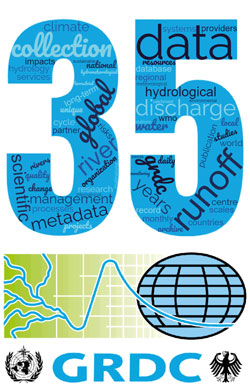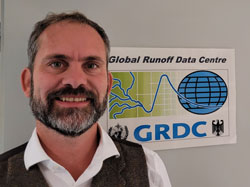On 14 November 2023, the Global Runoff Data Centre (GRDC) celebrated its 35th anniversary. In an interview with the public relations department of our hosting institution, the Federal Institute of Hydrology (BfG), the new head of GRDC – Dr Simon Mischel – spoke about the history, function and future of the data centre.
Question: Dr Mischel, why was GRDC set up, and how long has it been hosted by BfG?
Dr Simon Mischel: GRDC has been hosted by BfG since 1988. However, its origins lie in the first Global Atmospheric Research Programme, for which the WMO collected discharge data in the early 1980s. In actual fact, the primary aim of this programme was to collect physical parameters to gain a better understanding of processes in the atmosphere. However, it quickly became clear that discharge data plays a huge role in improving understanding of the climate. To begin with, this initial data set, which forms the core of GRDC, was hosted by LMU Munich. To establish a permanent service provision, the WMO mandated BfG, a departmental research institute of the German Federal Government, to set up GRDC. Finally, on 14 November 1988, the Global Runoff Data Centre was officially established at BfG in Koblenz under the auspices of the WMO.
What is the main function of GRDC, and where does the data come from?
Ever since it was set up, the core function of GRDC has been to collect and maintain historical river discharge data and make this available for international research projects. The data comes primarily from the national hydrological services in the WMO member states. Data is transmitted on a voluntary basis, but various WMO resolutions encourage the member states to supply data to GRDC. Support from the WMO is therefore hugely important to us. Once we’ve received the data, we check it, convert it into a standardised format and add it to our database. Users anywhere in the world can then download the data via the GRDC data portal. We have been working successfully in this way – as a facilitator between producers and us-ers of hydrological data – for some 35 years. We have also been a key partner in a number of data collection and data management projects.

Why is discharge data important, and for which studies is it used?
The “discharge” hydrological parameter is an important variable, both in the global water cycle and for water resource management. Moreover, discharge is also a relevant climate variable, since the flow of freshwater into oceans has an impact on temperature distribution, the salt content of the seas and oceanographic circulation systems.
According to our statistics, over the last two years, GRDC data was requested by users from more than 130 countries. Around three quarters of all the associated studies are connected to the climate or hydrometeorology, and the data is frequently used to calibrate and validate numerical models, such as in relation to hydrological drought and flood monitoring services. Users range from students who need the data for a thesis or dissertation to international research programmes and organisations conducting global studies. GRDC itself is also involved in some of these studies, such as the WMO “State of Global Water Resources” report and the “Global Climate Observing System (GCOS)” report, the findings of which directly inform UN Climate Change Conferences.

How good is the data coverage, and in what resolution is the data available?
GRDC hosts the most extensive global database of quality-controlled discharge data – year-book data or historical data. We collect only daily and monthly mean values – no unverified real-time data is collected. We currently have discharge data from approximately 10,700 stations in 160 countries in the database. Most of these stations are in Europe and North America, and the average time-record length is 40 years. The longest time record, which originates from the Dresden station on the Elbe, dates back to 1806.
It is important that we map data sets that are as long and complete as possible for climate research and hydrological modelling. We particularly include data from stations that reflect the hydrology of a river or region. Stations located in the estuaries of major rivers are also important for better quantifying the volume of freshwater entering our oceans. Stations where there is minimal human influence are also valuable and attract a great deal of interest in relation to global change and climate change.
Discharge is just one of many important hydrological parameters. Are there other global data centres?
GRDC works in close collaboration with the International Centre for Water Resources and Global Change (ICWRGC), which is based at BfG. ICWRGC also hosts two other global water data centres, namely the GEMS/Water Data Centre (GWDC), which collects water quality data on behalf of the United Nations Environment Programme, and the International Soil Moisture Network ISMN. In Germany, there is also the Global Precipitation Climatology Centre (GPCC), which is operated by Germany’s National Meteorological Service DWD. World-wide, there are also other global water data centres, which are collectively responsible for collecting different parameters relating to the hydrological cycle (e.g. for groundwater, isotopes, lake observations and glacier observations). These are operated by other nations and under the auspices of various organisations. They are important partner data centres for us, and we work in close collaboration with them in the context of the Global Terrestrial Network – Hydrology (GTN-H), which is hosted in the ICWRGC under a mandate from the WMO. The GTN-H is a Global Climate Observing System (GCOS) programme. In this international network, we are a strong partner in the UN-Water “family” and contribute towards United Nations reporting.
As the new head of GRDC, which challenges are you looking forward to?

As the new head, I am naturally keen to successfully carry forward the GRDC brand – a brand that is held in high esteem all over the world – and to continue looking after and expanding existing collaborations. To give you some examples, these particularly include contact with our users, data suppliers, the WMO as patron, ICWRGC as an international partner at BfG and our partner data centres.
However, as a team, we are, of course, also aware of the very fast technical progress that is being made in relation to data and digitalisation. For example, the global call for open and large datasets that comply with the FAIR (findable, accessible, interoperable, reusable) principles is constantly growing.
We are therefore already working, step by step, on making GRDC “fair”. This includes use of free software and offering our users access to data via data repositories and programming interfaces. A recent milestone in this respect is the publication of the Caravan dataset. With this, we can offer researchers a partial dataset of free GRDC stations, including meteorological data and river basin attributes. Our aim is to develop GRDC as a digital service provider for global discharge data and operate it at BfG on the basis of reliable data infrastructure.